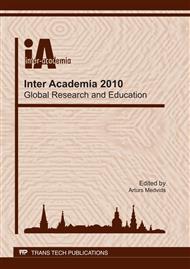p.40
p.44
p.48
p.52
p.56
p.62
p.66
p.70
p.74
Band Bending of n-GaP(001) and p-InP(001) Surfaces with and without Sulfur Treatment Studied by Photoemission (PES) and Inverse Photoemission Spectroscopy (IPES)
Abstract:
Surface electronic structures of n-GaP(001) and p-InP(001) with and without sulfur treatment have been studied by X-ray photoelectron spectroscopy (XPS), synchrotron radiation photoemission spectroscopy (SRPES), and inverse photoemission spectroscopy (IPES). The Fermi level (EF) of a clean n-GaP(001)-(2x4) surface is found to be pinned at 0.2 eV above the valence band maximum (VBM), suggesting that the surface electronic bands are bent upward. XPS spectra reveal that the EF is moved to 2.3 eV above the VBM by the sulfur treatment, implying that the sulfur-treated surface has flat bands. The IPES result shows that empty dangling bond states on Ga atoms at the surface are located at the conduction band minimum (CBM) and they disappeared with the treatment. SRPES spectra of a clean p-InP(001)-(2x4) surface indicate that the EF is located at 0.3 eV above the VBM and surface states due to phosphorus atoms are at –0.9 eV below the EF. The result implies that the surface has almost flat bands. Empty dangling bond states on In atoms at the clean surface are found to be located at the conduction band edge. Surface states due to the In-S bonds are found at –3.5 eV below the EF for the sulfur-treated surface. The sulfur treatment of the clean surface leads to a little shift (0.1 –0.2 eV) of the EF and to considerable reduction of the empty states in the band gap. A type conversion of p- to n- is not observed in the present work. This is discussed in terms of the thickness of a sulfide layer.
Info:
Periodical:
Pages:
56-61
Citation:
Online since:
April 2011
Authors:
Keywords:
Price:
Сopyright:
© 2011 Trans Tech Publications Ltd. All Rights Reserved
Share:
Citation:


